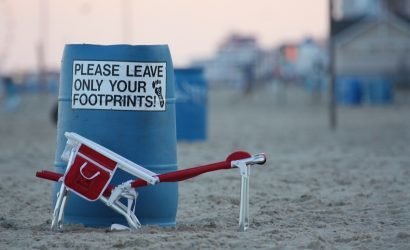As the USS Arthur W. Radford sank quickly to its resting place at the bottom of the Atlantic Ocean, former combat systems officer Douglas Warner lit up a cigar with a few of his fellow seamen on the retired Naval Destroyer to pay homage to their former home, and to celebrate it’s new life as an artificial reef.
“It was pretty amazing”, said Warner, “I thought for awhile that it wasn’t going to go, and then I thought it was going to go down bow first, but it finally went down stern first the way they wanted it to, and once the water hit those bigger holes, it went down pretty quick.”
The Radford became the Del-Jersey-Land reef on Wednesday, the largest of its kind on the East Coast with almost 300 people eagerly watching from the Cape May/Lewes Ferry. The 563-foot retired Naval Destroyer had numerous square holes cut into the side of the stripped vessel and sunk in a much anticipated event that ended up taking more than 3 hours to start its descent to the ocean floor.
Yet, once water started rushing into those holes, the Radford was submerged in less than a minute, and will now become a home for various forms of aquatic life and a destination for divers and fisherman up and down the coast.
“Our artificial reefs bring in thousands of fishing and diving trips annually,” said Delaware Governor Jack Markell, “and that brings something else we like to see in our region: jobs. We’re excited and thankful for the successful collaboration between Delaware, New Jersey, and Maryland. Through this partnership, this ship represents a step forward in protecting our environment, promoting incredible biodiversity, and providing special recreation opportunities for families and explorers.”
The 14-month process to strip the destroyer for its shell to pass EPA’s environmental standards took place at the US Naval Yard in south Philadelphia, costing upwards of $900,000, a cost split between the three states.
“We think this is what we call epic reefing”, said Erik Zlokovitz, reef coordinator for the Maryland Department of Natural Resources, “it’s going to have 70-feet of vertical profile off the bottom, so this is going to be a big attraction for the party boats, charter boats, the mid-Atlantic scuba diving community, and because the reef is located 30 miles off shore it may attract larger fish like sharks and tuna, which is very exciting.”
The Radford now sits about 150-feet deep at a location 30 miles offshore and equidistant between Cape May, New Jersey, Delaware’s Indian River Inlet, and Ocean City, Maryland.
Yet, for Warner and the more than two dozen former crew members of the USS Radford, (which was commissioned by the US Navy from 1977-2003), watching the vessel sink was somewhat bittersweet.
“Our mission was to essentially make sure that she didn’t go down to the bottom of the ocean”, said Warner, “so to watch her go down is bittersweet, but it’s great that she’s taking on new life as a reef. I can’t wait to go scuba diving on her next summer.”
For further details and audio of the event, listen to Russo's weekly public radio show, Coastal Connection, airing Friday's at Noon and 8pm on WAMU 88.3 in Ocean City or visit here.









